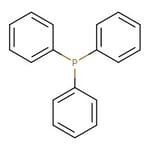Search Thermo Fisher Scientific
Thermo Scientific Chemicals
Triphenylphosphine, powder, 99%, Thermo Scientific Chemicals
Catalog number: L02502.30
250 g, Each



Thermo Scientific Chemicals
Triphenylphosphine, powder, 99%, Thermo Scientific Chemicals
Catalog number: L02502.30
250 g, Each
Quantity
Catalog number: L02502.30
also known as L02502-30
Price (USD)
Price: 85.50
Online price: 72.65
Your price:
Quantity
-
Chemical Identifiers
CAS
603-35-0
IUPAC Name
triphenylphosphane
Molecular Formula
C18H15P
InChI Key
RIOQSEWOXXDEQQ-UHFFFAOYSA-N
SMILES
C1=CC=C(C=C1)P(C1=CC=CC=C1)C1=CC=CC=C1
Specifications
Appearance (Color)
White to pale cream
Assay (GC)
≥98.5%
Identification (FTIR)
Conforms
Form
Powder or crystalline powder
Melting Point (clear melt)
79-83°C
Description
Triphenylphosphine is used in the synthesis of organic compounds due to its nucleophilicity and its reducing character. It is involved in the synthesis of biaryl compounds, phosphonium salts and other phosphorus compounds. As a reducing agent, it is used to prepare aromatic amines from the corresponding aromatic N-oxides. The anionic phosphine is usually isolated as the trisodium salt, which reacts with rhodium to form a complex that finds use in industrial hydroformylation reactions. It is also used to prepare Wilkinson's catalyst, RhCl(PPh3)3 useful to catalyze the hydrogenation of alkenes and tetrakis(triphenylphosphine)palladium(0) that is widely used to catalyse C-C coupling reactions in organic synthesis.
This Thermo Scientific Chemicals brand product was originally part of the Alfa Aesar product portfolio. Some documentation and label information may refer to the legacy brand. The original Alfa Aesar product / item code or SKU reference has not changed as a part of the brand transition to Thermo Scientific Chemicals.
Applications
Triphenylphosphine is used in the synthesis of organic compounds due to its nucleophilicity and its reducing character. It is involved in the synthesis of biaryl compounds, phosphonium salts and other phosphorus compounds. As a reducing agent, it is used to prepare aromatic amines from the corresponding aromatic N-oxides. The anionic phosphine is usually isolated as the trisodium salt, which reacts with rhodium to form a complex that finds use in industrial hydroformylation reactions. It is also used to prepare Wilkinson′s catalyst, RhCl(PPh3)3 useful to catalyze the hydrogenation of alkenes and tetrakis(triphenylphosphine)palladium(0) that is widely used to catalyse C-C coupling reactions in organic synthesis.
Solubility
Soluble in ether, benzene, carbon tetrachloride, glacial acetic acid, acetone, chloroform and alcohol. Insoluble in water.
Notes
Incompatible with oxidizing agents and acids.
Triphenylphosphine is used in the synthesis of organic compounds due to its nucleophilicity and its reducing character. It is involved in the synthesis of biaryl compounds, phosphonium salts and other phosphorus compounds. As a reducing agent, it is used to prepare aromatic amines from the corresponding aromatic N-oxides. The anionic phosphine is usually isolated as the trisodium salt, which reacts with rhodium to form a complex that finds use in industrial hydroformylation reactions. It is also used to prepare Wilkinson′s catalyst, RhCl(PPh3)3 useful to catalyze the hydrogenation of alkenes and tetrakis(triphenylphosphine)palladium(0) that is widely used to catalyse C-C coupling reactions in organic synthesis.
Solubility
Soluble in ether, benzene, carbon tetrachloride, glacial acetic acid, acetone, chloroform and alcohol. Insoluble in water.
Notes
Incompatible with oxidizing agents and acids.
RUO – Research Use Only
Figures
Documents & Downloads
Certificates
Search by lot number or partial lot number
Frequently asked questions (FAQs)
Citations & References
Search citations by name, author, journal title or abstract text